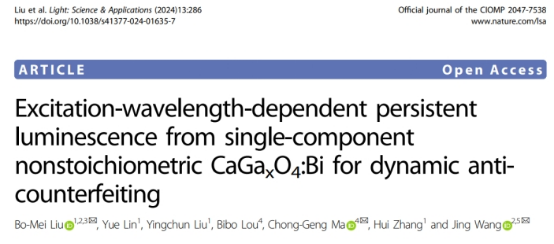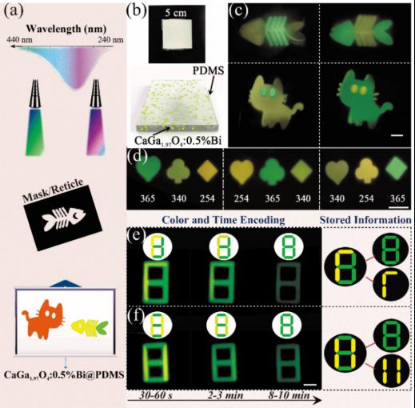Light Industry and Chemical Engineering College Professor Zhang Hui's team in《Light: Science & Applications》(Nature sub-journal) published a research paper
Author: Source: Release Date: 10/17/2024 Browsing: 215 times
Recently, Associate Professor Liu Bomei from our college's Professor Zhang Hui's team, in collaboration with researchers from Sun Yat-sen University and Chongqing University of Posts and Telecommunications, wrote the academic paper "Excitation-wavelength-dependent persistent luminescence from single-component nonstoichiometric CaGaxO4:Bi for dynamic anti-counterfeiting," which was published on October 10, 2024, in the international top optics academic journal《Light: Science & Applications》(Nature sub-journal; impact factor: 20.6). Associate Professor Liu Bomei from our college is the first author and corresponding author of the paper. The research work is based on the Jieyang Branch of the Guangdong Provincial Laboratory of Chemistry and Fine Chemicals (Rongjiang Laboratory), with Guangdong University of Technology as the first completing unit of the paper.

Research results introduction as follows:
Long-persistent luminescent materials with tunable and controllable optical properties have great application value in ultraviolet light sensing, information display, and encryption. However, achieving single-component, multi-modal, and dynamically color-tunable long-persistent luminescence in chemically stable inorganic material systems faces significant challenges. The research team, based on the design concept of defect engineering, introduced cation vacancy defects through non-stoichiometric component design. This formed microenvironments in the inorganic crystal structure consisting of multiple luminescent centers and multiple trap centers, which respond to different excitation lights and store energy in localized structures. Ultimately, through thermal vibration or tunneling effects, the energy is gradually released to produce continuously tunable "orange-yellow-green" persistent luminescence. Combining experiments and theoretical analysis, the mechanism of multi-color persistent luminescence in response to excitation wavelength stimulation was elucidated. Utilizing the material's unique excitation wavelength-dependent multi-color persistent luminescence feature, dynamic optical information writing and display based on excitation method, persistent luminescence color, and time resolution were demonstrated. The developed materials and verification methods reveal their application potential in advanced anti-counterfeiting and optical information display and encryption fields.

Multi-color persistent luminescence and time-encoded information display based on excitation wavelength-dependent long-persistent luminescent materials
Original link:https://www.nature.com/articles/s41377-024-01635-7
 current position:
Home
>
News & Notices
>
News
>
Content
current position:
Home
>
News & Notices
>
News
>
Content